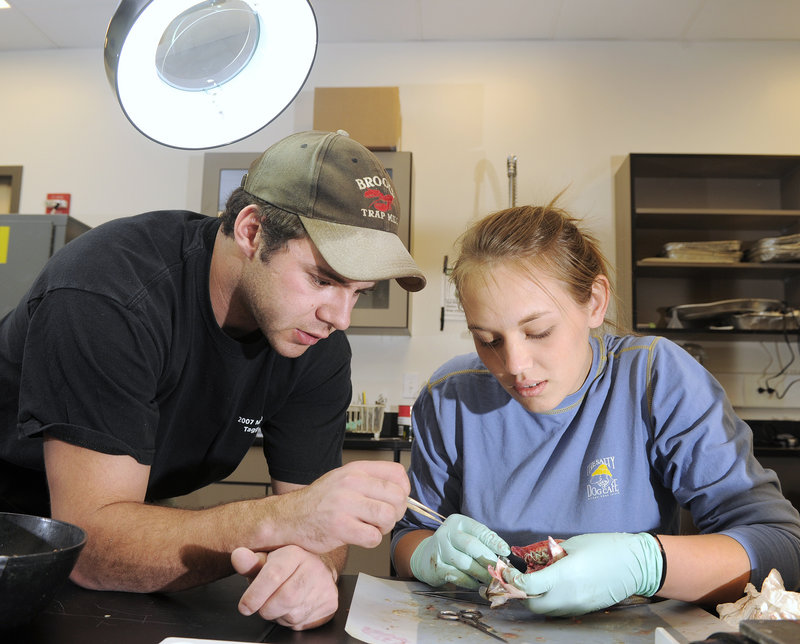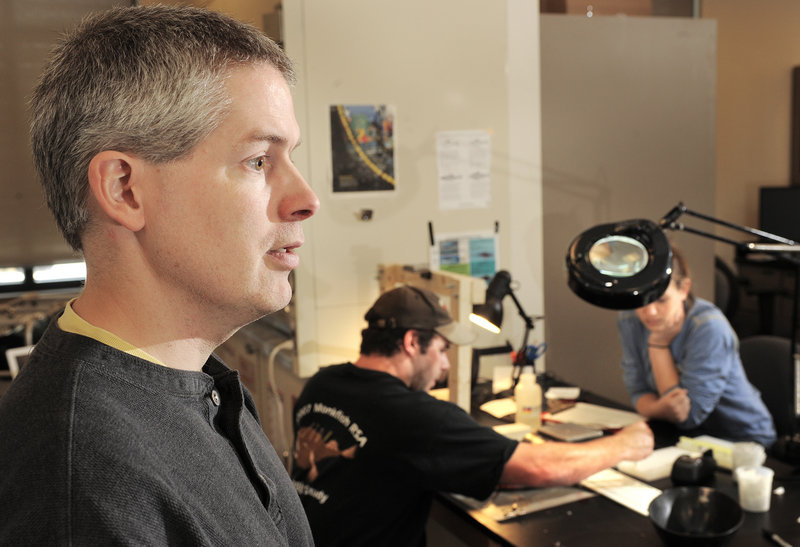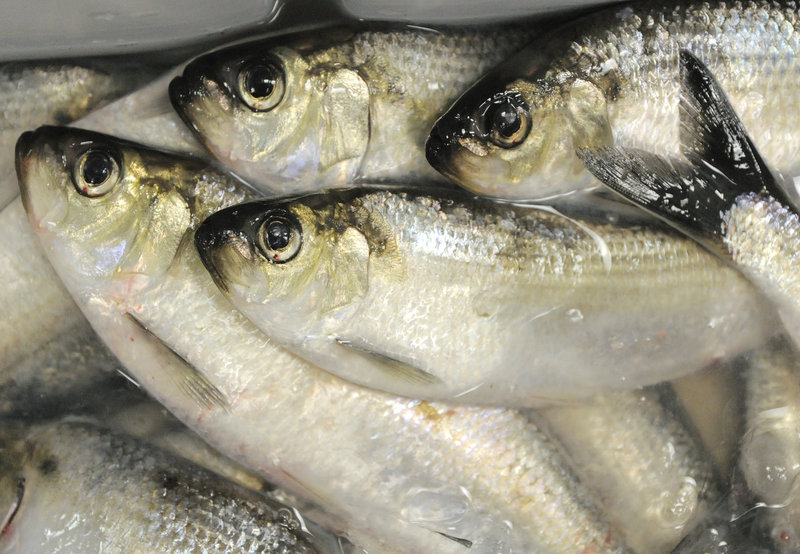PORTLAND – The odor of dissected fish permeates the lab room at the Gulf of Maine Research Institute as Zach Whitener slices open a freshly caught alewife.
Dumping the roe onto a scale, he snips and probes among the cartilage to extract the pinhead-sized ear bone.
It is a messy, odoriferous job, but Whitener said he doesn’t mind.
“Quite the opposite,” he said.
Whitener, who grew up on Long Island and graduated from Brown University last year, is part of a team of researchers working to unlock some of the mysteries surrounding the shimmering fish, which, along with the blueback herring, are known as river herring.
The nearly $600,000 project is funded by grants, including $225,000 from the National Fish and Wildlife Foundation. The foundation is dispersing $1.9 million in Maine from the $37 million in fines that Overseas Shipholding Group had to pay for repeatedly dumping waste oil off the East and West coasts. The rest of the money is from smaller state and federal grants.
Like the Atlantic salmon and other anadromous fish, which live in salt water but return to freshwater rivers and lakes to spawn, the alewife population has declined drastically. In the late 1950s, 70 million pounds of river herring were being landed along the East Coast annually, compared with fewer than 1 million pounds today. Researchers are trying to understand what is causing the decline.
“There is a lot of pseudoscience out there, but we really don’t know,” said Jason Stockwell, a scientist at the institute who is running the project with colleagues Theo Willis and Karen Wilson from the University of Southern Maine.
Some blame the population decline on dams, which prevent the fish from reaching their spawning grounds upriver; increased predation from resurgent populations of striped bass; overfishing; pollution; a change in the chemistry of lakes and ponds, or a combination of factors.
Some of the theories have holes. Water quality has improved dramatically after four decades of the Clean Water Act, and dam removals and the installation of fish passages along the East Coast are reopening access to spawning grounds.
Not much is known about alewives, Stockwell said. It is unclear where they migrate or whether the fish born in a particular river continue to school together or disperse.
Maine’s alewife population is relatively healthy compared to other states, but scientists do not know why.
Massachusetts, Connecticut, Rhode Island, North Carolina and Virginia have placed a moratorium on fishing for alewives. Other states, including Maine, may be forced to follow due to new federal regulations that require states to prove that their existing alewife fisheries are sustainable.
“It will be up to the Atlantic States Marine Fisheries Commission,” said Michael Brown, a marine resource scientist at the Maine Department of Marine Resources.
Alewives and other river herring are managed by the state along the coast of Maine and by the state and 41 municipalities in rivers and lakes, although only 15 communities have active fisheries.
The communities, such as Damariscotta, lease permits to harvesters. While river herring were once a popular food fish, today they are mainly used as lobster bait.
The annual catch in Maine is worth about $250,000, according to the Department of Marine Resources.
Alewives are far more valuable in other ways. They provide a protective cover from predators for the tiny number of Atlantic salmon that are migrating upriver at the same time. They are a food source for osprey, herons, bears, otters, cod, haddock, whales, seals and other animals.
When they die in lakes after spawning, they provide nutrients for phytoplankton.
Alewives returning to the Atlantic transfer phosphorus, which causes algae blooms, from lakes to the ocean.
With the alewives just beginning to show up now in Maine rivers and streams, the two-year project — which is trying to determine whether each river and lake has its own distinct population of the fish — is shifting into high gear.
The 12 full-time and 12 part-time researchers and assorted volunteers are taking fish samples from 14 rivers and nine lakes and ponds from Saco to East Machias.
The work started last week with a cooler full of alewives from the Nemasket River in Massachusetts, which will serve as a comparison population. Each of the 100 fish in the batch is measured, weighed and photographed.
The researchers also conduct tests on the ear bone to determine the age of the fish. A fin sample is taken for genetic analysis.
At the same time, the researchers will be studying alewives caught at sea inadvertently as bycatch by fishermen who are trying to harvest other species. Stockwell said if it is determined that alewife populations are distinct and they return to where they were born to spawn, researchers can assess the alewives caught in bycatch and be able to predict a drop in population in their specific spawning grounds.
Knowing the answer to that question will help scientists understand what is happening to other species, such as cod and other groundfish that feed on alewives.
Stockwell said the project will develop an accurate method for monitoring the alewife population in the future, and it could provide answers to other mysteries surrounding the fish.
“This population has been ignored,” Stockwell said.
Staff Writer Beth Quimby can be contacted at 791-6363 or at: bquimby@pressherald.com
Send questions/comments to the editors.






Success. Please wait for the page to reload. If the page does not reload within 5 seconds, please refresh the page.
Enter your email and password to access comments.
Hi, to comment on stories you must . This profile is in addition to your subscription and website login.
Already have a commenting profile? .
Invalid username/password.
Please check your email to confirm and complete your registration.
Only subscribers are eligible to post comments. Please subscribe or login first for digital access. Here’s why.
Use the form below to reset your password. When you've submitted your account email, we will send an email with a reset code.